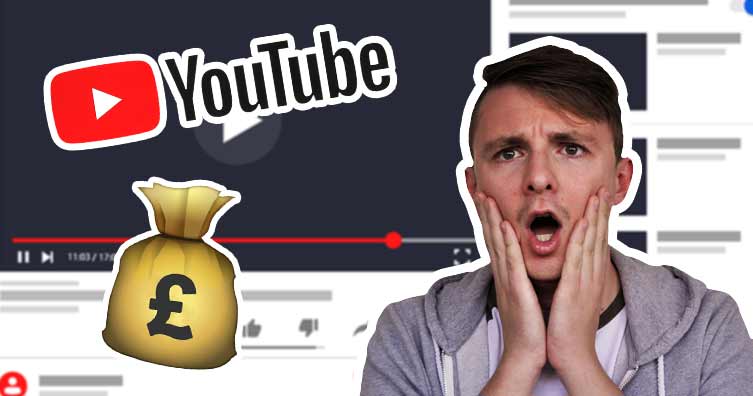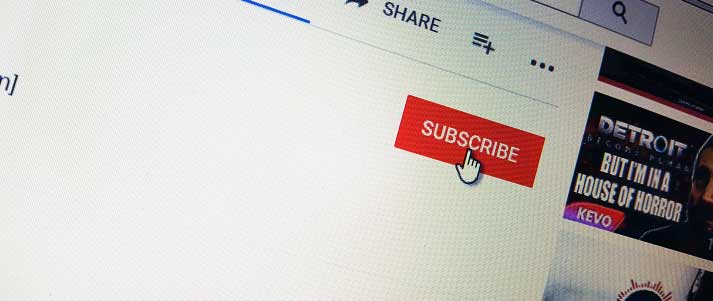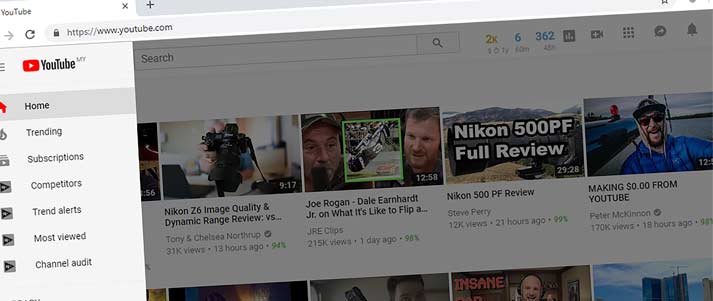Remember that viral YouTube video that made you spit your tea out this morning? That video could have earned the creator £1,000s. Here's how you could do it too.

Credit: rvlsoft (logo), Mary_ART_S (background) - Shutterstock
We're not kidding when we say you can earn serious money from YouTube videos. And it might just be the most enjoyable money-making trick out there.
Admittedly it isn't as easy as clicking your fingers and the money appearing in your bank account like magic. But nonetheless, making money out of YouTube videos is still a relatively simple concept.
To help you earn some dollar, we've put together this step-by-step guide. You can thank us later by sending us some of your earnings, yeah?
How to earn money from YouTube videos
How much money can you make from YouTube?

Credit: Kathy Hutchins - Shutterstock
Straight in there with the killer question. We don't mess about. As for the answer? Well, it's a bit of a mixed bag, if we're honest.
While you might get lucky in waking up to find your video has gone viral, this is very unlikely. Nowadays short funny videos tend to go viral through Facebook and Twitter instead of YouTube, so the chances of your autotuned cat video (yes, really) exploding overnight on YouTube are relatively low.
You're much more likely to build up revenue by getting an audience through regular content publishing – whether that's making vlogs, playing through a popular video game, or yes, filming your cat (autotuned or otherwise).
How much can you realistically expect to make from YouTube?

Credit: Gage Skidmore - Flickr
We've all heard of the likes of Zoella, PewDiePie and Logan Paul (plus other more agreeable people) earnings millions of pounds every year from their YouTube channels. But for the majority of YouTubers, the earnings are a lot more modest.
As a benchmark, you can expect to make around $1.50 per 1,000 views (about £1.10 per 1,000 views, at the time of writing). This means that one million views equals $1500... or around £1,100 to us British folk.
However, more popular channels and videos can earn closer to £6 or £7 per 1,000 views – so it quite literally pays to be popular.
We spoke to Jack Allen, a student who makes money from his YouTube channel, Tezla. He explained that it's difficult to put an exact figure on how much you can earn, as each video will perform differently.
It took me about three years to get to a stage where I was earning more than a few pence for making videos, but it depends how lucky you get with making a video going viral.It's hard to say how much I make per video, as my average videos that only got a few thousand views hardly made me anything.But the few videos that went viral earned me around $200 for every one million views.Jack Allen, Tezla YouTube channel
Also keep in mind that YouTubers and channels often produce their own merchandise or sign advertising contracts with relevant companies – both of which can substantially add to the income generated from video views alone.
Advertising contracts, which usually involve you posting videos promoting or featuring a product, often pay several thousands of pounds. And if we assume that you're able to convince your YouTube subscribers to follow you on Instagram, you could earn anything from £40 – £2,000+ for promoted posts there, too.
Read on to find out more about these extra streams of income!
Find out more about how much money you can make from social media, including how to do it, in this guide.
Multi-channel networks

Credit: Abdie - Shutterstock
If you've already done a bit of research into making money on YouTube, you may have come across the term 'multi-channel networks' or 'MCNs'. As the name suggests, MCNs are essentially management groups for YouTube channels – a bit like how multiple musicians will be signed to a single record label.
Being part of an MCN could give you access to better quality production and editing facilities, the opportunity to collaborate with other channels or celebrities, as well as help with marketing and growing your channel.
The dangers of MCNs
In return for the support an MCN gives you, you'll need to sacrifice a percentage of your earnings as well as other creative privileges. This sounds fair in principle, but MCNs are often accused of abusing their power and serving up a rough deal for their content creators.
Jack suggested to us that he could have earned a lot more from his videos had he not been "in a very bad advertising network and legally locked into a contract" – and it's not just the smaller channels that fall victim to MCN greed, either.
Ray William Johnson, one of the first big YouTube success stories, was reportedly pressured by Maker Studios to sign a contract that would give the company 40% of his Google Adsense revenue, as well as 50% of his channel's intellectual property.
Johnson refused to sign the contract, and Maker Studios eventually shut down the production on one of his albums, as well as his flagship show Equals Three.
So, while joining a multi-channel network can be a great way to take your work to the next level, you should never sign a contract that you're not happy with. These companies can, will and have taken advantage of content creators before, and you could end up earning less money than you would if you'd just gone it alone!
How does the YouTube Partner Programme work?

Credit: Warner Bros
The YouTube Partner Programme (YPP) is a scheme that allows video creators on the site to start monetising their content. Members of the programme can earn money from a number of sources, including:
- Adverts on your videos
- YouTube Premium subscribers watching your content
- Channel memberships (where paid subscribers get exclusive content)
- Super Chats (where viewers in a live chat can essentially boost their comment to make it more visible to the streamer)
Joining the YouTube Partner Programme
Unfortunately, you won't be able to become a member of YPP if you have just one viral video to your name.
Before you can join, you'll need to have over 1,000 subscribers and your videos must have been watched for a total of over 4,000 hours in the last 12 months. You'll also need to adhere to YouTube's community guidelines and terms of service.
Once you're in, you'll need a Google AdSense account. Don't worry if you think your viewers will be put off by commercials – you can choose which types of ads appear on your videos, like skippable clips or overlaying banners.
Oh, and just to be clear, you can't monetise any videos with copyrighted material in them. So if you filmed a short section of a gig and put it on YouTube, you wouldn't be able to make money from any ads on this video.
Of course, reaching the thresholds required to join the YouTube Partner Programme is a big ask. Here's what Jack had to say when we asked him how to grow your channel to the point where you can join YPP:
Firstly, you should upload consistently – not necessarily daily, but maybe a few times a week. Make sure you don’t have gaps of a few months, as people tend to forget you exist!You can schedule videos on YouTube so they'll upload if you're away somewhere, so getting ahead of your videos is a good plan!You should also spread your videos onto other platforms, like social media, as this can really help to spread your name.Finally, make friends on YouTube! Obviously you should be careful, but doing collaboration videos is a great way to expand your brand.
What do you need to start a successful YouTube channel?

Credit: ImageBySutipond - Shutterstock
Depending on what you're planning to capture on film, you'll need to get the right set-up sorted early doors.
There's no point in using your iPhone to record the most hilarious vlogs ever seen – a decent set-up goes a long way towards showing that you're serious and having people respect your videos. This is a sentiment that Jack echoes, too.
If you want a video to look professional, make sure you have an HD camera or webcam (not a phone!), an external microphone, a computer and some editing software.If you're recording console games you'll need a game capture card too!
Jack was also generous enough to share his tips for the specific equipment and software he'd recommend for someone starting out on YouTube. We've combined his advice with some of our own pearls of wisdom to create a six-point list to getting started on YouTube.
YouTube channel starter kit
- A decent camera or webcam – Quality is important and you'll need to record your videos in full 1080p HD if at all possible. Jack recommends the Canon G7X if you're after a camera, or the Logitech C920 if you'd rather use a webcam (which also happens to be much cheaper than a camera!)
- Video editing software – iMacs have pretty decent video editing software included (iMovie), but for PC users or iMac owners who want something a little more advanced, there are more options. Jack recommends a few programs (Adobe Premier, VEGAS and Final Cut Pro), or you can try Lightworks, as featured in our guide to the best free software alternatives
- Microphone – Most cameras come with a microphone, but if you're looking for top sound quality you might need to purchase a separate device altogether. Depending on your budget, Jack recommends either the Blue Snowball, Blue Yeti (used by us on our podcast!) or the RODE Podcaster
- Lighting – Splashing out on lighting isn't essential, but some top YouTubers swear by it. You can either get creative with the lights you already have around the house, or you can buy some dedicated video lighting
- A decent backdrop – If you're filming a vlog, you might want to set up a decent backdrop. You can stick with a plain colour, or jazz it up a bit by making whatever room you're filming in look really nice (but not too distractng!)
- Capture card – You'll only need one of these if you want to record console games. If that's what you intend to be doing, Jack's card of choice for starters is the Elgato HD60.
How to make the best YouTube videos

Credit: Ricky Kresslein - Shutterstock
As we touched on earlier, you don't get paid until you get popular – and the more popular you get, the more you get paid. Annoying as this is, it makes sense really. You wouldn't pay to advertise on a billboard that nobody walks past, so why pay to advertise on a video nobody watches?
Although building up a decent audience might seem daunting, Jack acts as proof that you can still manage it alongside your day-to-day life (he got started while he was still at school!). Here are some of his top tips, plus a few of our own.
How do you make a successful YouTube channel?
Be confident
Nobody wants to watch someone who's afraid to look at the camera, but being cocky can be off-putting too.Don't be overly confident to a point where it’s cringey, but don’t be shy either. Convince your audience that they should be watching you.Follow popular trends
Pay attention to what other popular channels are posting right now, and not just what's done well in the past – there's no point in doing a Harlem Shake video in 2019, after all.If you were to start playing FIFA 17, you wouldn't get any views and newer editions have come out and that game is not relevant anymore.Find your niche and be unique
 This might sound like we're contradicting ourselves, but Jack agrees: being unique is just as important as following trends.If you do the same thing as someone else, the chances are that people will prefer to watch the person who gets a million views on every video.With that in mind, take some time to think about what you can do well, and whether you think people would be interested in it. Better still, look at the popular trends and figure out how to add something new to them.For example, gaming videos are super popular on YouTube – but as such, it's also an incredibly competitive area to break into. See if you can think of a unique spin to put on the genre – if you can, you may have just found your niche!Other popular categories include product reviews, comedy, beauty vlogs and general 'how to' guides – again, see if you can think of a way to capitalise on these trends while still setting yourself apart from the crowd.Don't worry if you start off without a clearly refined idea of what you want to do – as Jack has shown, there's space to evolve.My content started out purely as gaming videos, but as YouTube as a platform started to adapt, I adapted with it. This lead to my most successful content being all about FIFA, football and IRL vlogs and challenges.
This might sound like we're contradicting ourselves, but Jack agrees: being unique is just as important as following trends.If you do the same thing as someone else, the chances are that people will prefer to watch the person who gets a million views on every video.With that in mind, take some time to think about what you can do well, and whether you think people would be interested in it. Better still, look at the popular trends and figure out how to add something new to them.For example, gaming videos are super popular on YouTube – but as such, it's also an incredibly competitive area to break into. See if you can think of a unique spin to put on the genre – if you can, you may have just found your niche!Other popular categories include product reviews, comedy, beauty vlogs and general 'how to' guides – again, see if you can think of a way to capitalise on these trends while still setting yourself apart from the crowd.Don't worry if you start off without a clearly refined idea of what you want to do – as Jack has shown, there's space to evolve.My content started out purely as gaming videos, but as YouTube as a platform started to adapt, I adapted with it. This lead to my most successful content being all about FIFA, football and IRL vlogs and challenges.Choose a good channel name
This might sound trivial, but trust us – it isn't.Just as you wouldn't expect an employer to take your CV seriously if you sent it from taylorswiftfan2k17xx@hotmail.co.uk, people are less likely to give your YouTube channel the time of day if your username is... well, taylorswiftfan2k17xx.Look at the usernames of some your favourite YouTubers for some inspiration on the kind of vibe to go for, but again, keep it unique and distinctive if possible!Be yourself
It's one of our top tips for making friends at uni, and to be honest, it applies to all areas of life. If you've ever tried to take on a new persona, you'll know it eventually becomes unbearably tiring and that you'll inevitably let your real self show at some point.And that's not to mention the fact that, unless you're a pretty skilled actor, your viewers will probably pick up on the fact that you're faking it.According to Jack, pretending to be someone you're not is a depressingly common mistake made by YouTubers.There are countless examples of YouTubers putting on a fake persona for videos and it now backfiring as they don’t want to be that person anymore. People should follow you for who you are.Use catchy, relevant titles and thumbnails
 Credit: Denys Prykhodov - ShutterstockSee the header photo at the top of this article? In case you hadn't realised, it's parodying the kind of thumbnails you see on YouTube – and it's all in aid of getting people to click on thatvideo over all the others.Clickbait is a necessity nowadays on YouTube – if a video doesn’t look appealing from the thumbnail and title, people won’t click on it.Make sure you have a thumbnail and title that makes your video look interesting and makes people want to find out more.That being said, don’t put something in there that's not related to the video or is just a complete lie – YouTube have caught people out for this and have banned their channels.
Credit: Denys Prykhodov - ShutterstockSee the header photo at the top of this article? In case you hadn't realised, it's parodying the kind of thumbnails you see on YouTube – and it's all in aid of getting people to click on thatvideo over all the others.Clickbait is a necessity nowadays on YouTube – if a video doesn’t look appealing from the thumbnail and title, people won’t click on it.Make sure you have a thumbnail and title that makes your video look interesting and makes people want to find out more.That being said, don’t put something in there that's not related to the video or is just a complete lie – YouTube have caught people out for this and have banned their channels.Upload content regularly
We mentioned this earlier, but it bears repeating: if you want your channel to become popular, and to stay popular, you'll need to upload content on the regular.What's more, whether you opt for daily, weekly or monthly videos, try to post them at regular intervals. Posting on a specific day each week helps your viewers keep track of when some new content will drop, and hopefully stops people nagging for the next video.Show you love your content
It's not enough to just be yourself, or to find a niche. Perhaps the most important thing of all is to show your viewers that you love what you're doing.Having a passion for what your videos, and your subject matter, will make an impact on how they're received – if you seem interested, chances are your viewers will be too!On the other hand, if you don't love what you're doing, you'll soon get bored and the videos will start to reflect that. Passion comes first, and the money comes second!Always make sure to follow the rules too: no inappropriate content, copyright or spamming. Play nice and you'll be making money before long!
More ways to make more money on YouTube

Credit: Nickelodeon
If you've managed to populate your channel with a fair few videos collection and have a dedicated audience, there are a few other avenues to explore aside from Google Adsense.
Affiliate marketing
One of the most accessible options is to take advantage of affiliate marketing. We touch on this a little more in our guide to making money from a website, but essentially affiliate marketing involves you posting a link to a website, and if someone makes a purchase through that link, you get a percentage of the sale.
Sometimes you'll even get paid if someone just clicks on the link without buying anything, and according to Jack, affiliate marketing is something that pretty much any YouTuber can try for themselves.
Sponsorship
As mentioned earlier, more popular YouTube channels often make money through sponsorship deals. These will often be related to the content on your channel, but from time to time you may be approached by a company that's just keen to get its name out there, no matter the channel.
And don't worry, you don't need to be at Zoella levels of success to nab yourself a sponsorship deal. As he explained to us, Jack's had more than just a couple of sponsorship deals down the years.
When you're at a decent view-per-video level, a sponsor will pay you a set amount per video for mentioning a product, or advertising them in the video intro.I've also had FIFA coin sponsorships, where I got given millions of coins per week for advertising them. This was great, as I could use the FIFA coins to make much better content in the future.
In that vein, even if you don't think you can get paid by an advertiser, it's worth approaching some companies to see if you can get some free sample or products in exchange for mentioning or reviewing them in your videos.
As long as you follow advertising guidelines, this could be a great way to benefit from your YouTube channel!
Donations
Sites like Patreon, Buy Me a Coffee and Ko-fi are great little tools that allow your fans to sign up and donate money if they'd like to help support your channel.
You're relying on people's good will and kind nature, but if you want to up the chances of them donating, you can offer them some exclusive content or products as a thank you for their small donation.
The key to doing well here is to build up an audience that really appreciate what you post. If they like what you do, the chances are they can be persuaded to spare a few bob each time you upload!
Merchandise
Depending on how successful you become, you could even consider branching out and creating your own merchandise.
Whether it's t-shirts, mugs, or even just something small like pens and badges, loyal fans will be keen to get involved if they feel like it makes them part of a community, and that they're supporting you.
Just don't do what some high-profile YouTubers have been accused of (cough, Zoella, cough), and charge way over the odds for what is essentially junk, just because your name is on it. If you want your fans to respect you, respect them back!




No comments:
Post a Comment